
We have compiled another report on the Skyforge development process. This time we will look at the development of a new class! This is serious and painstaking work and a real adventure for the entire team. To make the story more interesting, we will show you how the Outlaw class was created.
A new class is not just a challenge for us as developers, but also an excellent way to put our artistic skills to the test.
Skyforge Art Director Anton Lavrushkin
CONCEPT
Work on a new class begins with selection of the spot it will occupy within the existing palette. The game's class designer and art director determine what kind of experience the new character specialization will provide to players.
Every class in Skyforge carries out a certain role (attack, defense or support). The designer must first select one of these roles and outline the distinctive features of the class, before taking his requirements to the rest of the team.
All those involved in the design, concept, animation, visual effects and sound get together to discuss what the class designer wants and find ways to implement that vision. Or they come up with something new if the team cannot implement the designer's wishes or come across technical restrictions.
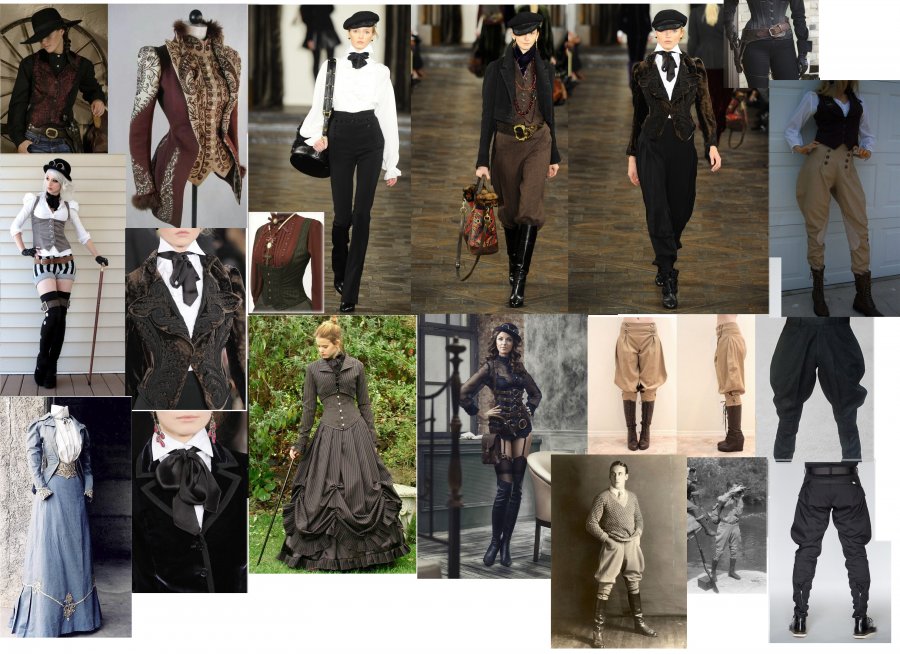
What personality will they have? Will they be good or evil, more fantasy or sci-fi? What will their weapons be like? How will it differ from that of the other classes? All this determines the external appearance of the weapon, the animation and effects of the future character.
Various ideas are generated and reviewed, after which 2-3 focuses for further development are selected. The end result should be sufficiently exciting, interesting and not too expensive to produce, in order to keep to the deadline.
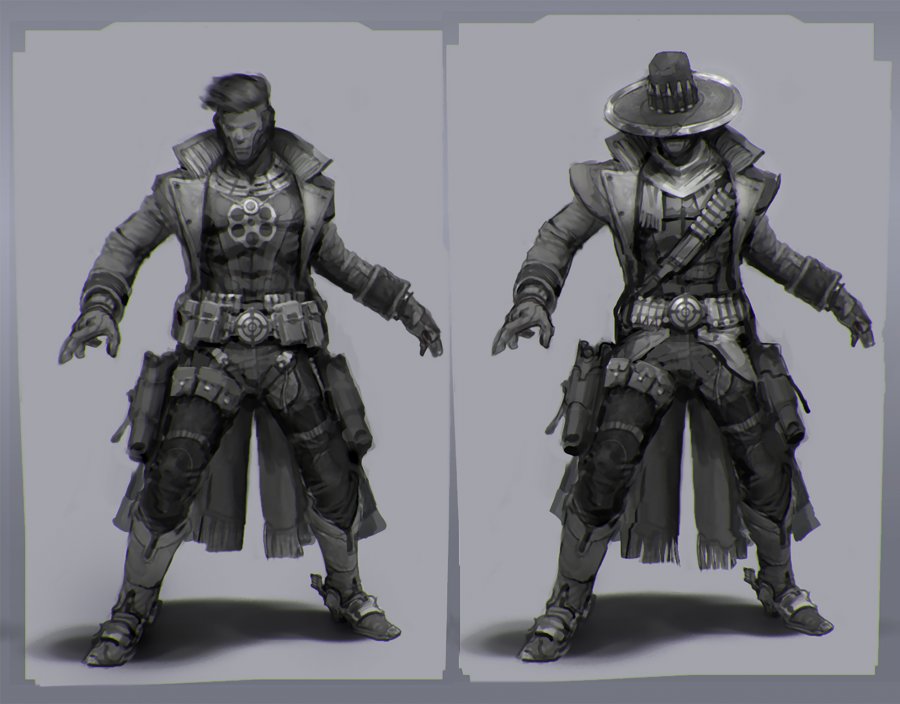
Production takes around 6 months. This is the time from when the designer and artists start developing the new class concept until the final quality control check. It took around 4 months to create the Outlaw. We were able to reduce the time thanks to our team's great experience, a smaller amount of class abilities and a clear vision of the end result.
DEVELOPING ABILITIES
The designer puts together a document outlining the mechanics of the character's abilities. Because we are working on a game that already has a considerable number of classes, the new class's DPS must lie within the range of the existing standards for each of the three roles. Individual cases are taken into account as well as general cases:
- maximum DPS during a Burst,
- DPS AoE,
- along with their duration and frequency.
As well as sorting out the numbers, we try and make each class special with unique and useful skills and control features.
So the Outlaw turned out mobile but not very resilient. He moves fast and can evade attacks, but is rather vulnerable to direct damage, and cannot boast the powerful defense skills that are inherent to the Necromancer, for example.
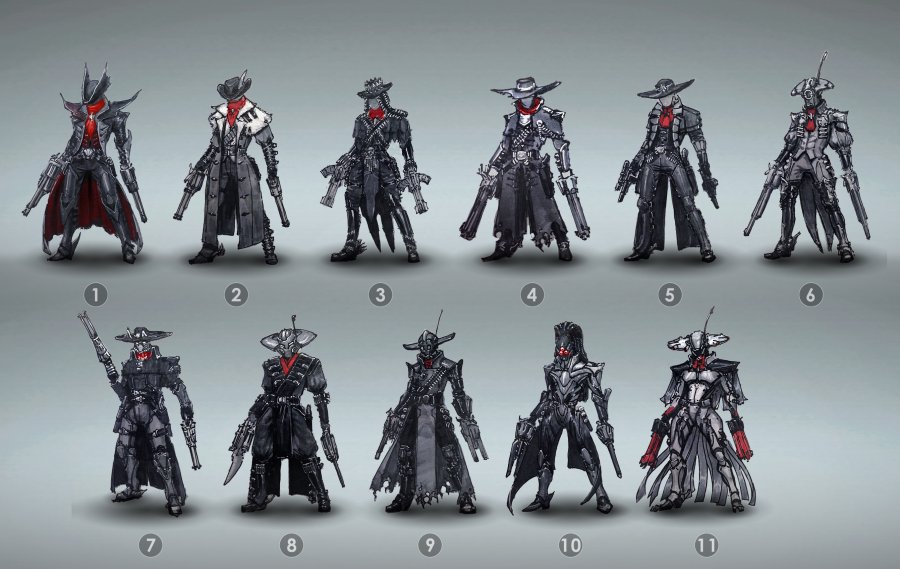
It is very important that the class skills "cover" all the character's basic requirements: damage to bosses, small groups (3-4 targets) and large groups (5 and more targets) of enemies, the opportunity to defend against attacks and powerful abilities with a lengthy rollback. The class should also have abilities with additional effects, which are activated randomly. This gives the player the chance to apply an enhanced version of abilities right away, providing a more striking impression from a battle.
The designer also sets up ability effects for PvP. For example, the Outlaw can escape the enemy's focus while using Lead Carousel, which is very helpful in the arena. This possibility is simply not needed in PvE and instead the ability inflicts greater damage and restores the Outlaw's energy.
Before the Outlaw appeared in the game, there were no classes that could effectively destroy tanks and characters in divine form. That is why we decided to give him the Head Hunter talent, which deals with this task extremely well. Duel stance ability damage is counted as a % of the target's maximum health, which enables him to effectively deal with enemy tanks.
The ability mechanics should motivate the player to press different buttons. It makes the player happy when abilities strengthen one another and are activated at a random time! They start to think about whether to use an ability now or accumulate resources and discharge all cartridge clips later?
Senior Game Designer Dmitry Borodin
It is important not to overdo it when it comes to abilities. So the ultimate Barrage ability in the PVE version has an additional AoE effect. If it worked in PvP, the ability would be too strong as it would be extremely difficult to avoid damage from it.
VISUAL DEVELOPMENT
Everyone knows that one of the key features of the game is the ability to freely switch between classes. To ensure that even novices can navigate the many possibilities, we highlighted four "layers" of visualization, which enable you to quickly understand the representatives of each class.
- Animation (stance, battle stance, displacement, attack and abilities).
- Weapons (type, form, volume, color, internal movement).
- Costume (character, style, animation, materials, color).
- Sound (character, dynamics).
All this underlines the individuality of each class. This is why Skyforge does not have a Knight with a pair of daggers, a Cryomancer with a hammer or a more absurd weapon.
Here we should note one nuance that is characteristic of our game. Class image is not primarily built from a figure's shapes, contours and colors (we cannot directly control with these parameters, but only indirectly with a well thought out costume), but from the form factor and the grasping (and attack) method of the weapons.
Skyforge Art Director Anton Lavrushkin
When the task is clear the concept artist steps in and tries to visually render the class image. The art director leads the compilation of a reference mood board that brings together visual images for each of the selected focuses. This could include photographs, illustrations, screenshots or any suitable images. A draft line is then created — several character options are presented for comparison. The line takes around a week to put together.
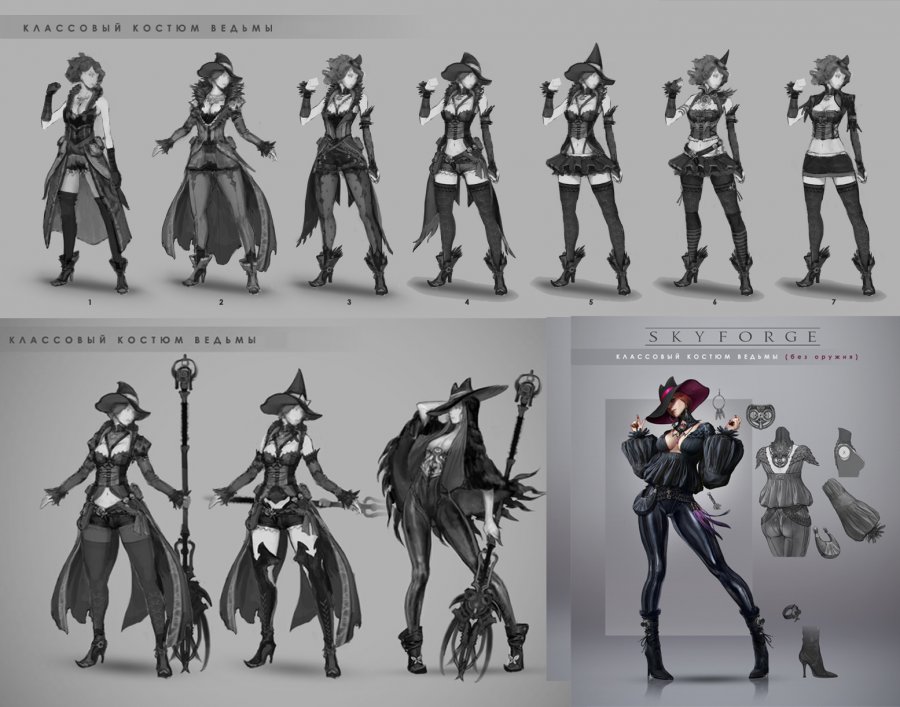
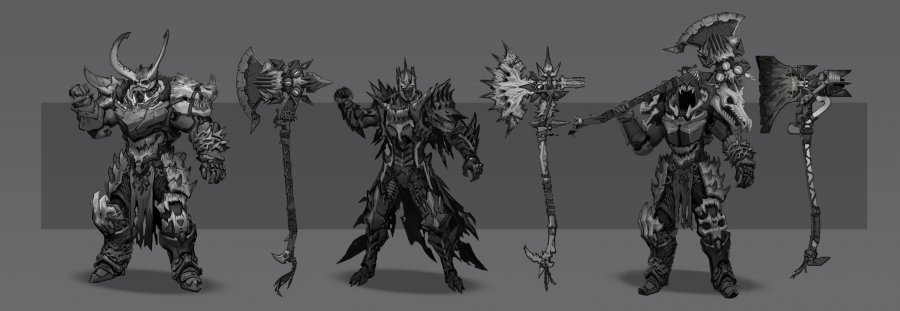
As well as shapes and color (weapons or costume), the concept artist determines what materials everything will be made of as this will affect the object's render engine. Skyforge uses physically based rendering (PBR), so objects look different depending on the surface properties (gloss, matt etc).
When the line is ready, the concept artist takes it to the team. Taking a fresh look at all the options proposed, the creative director and art director select the optimum variants. The necessary revisions are made to the draft concept and an estimate is given for the production term of all the necessary materials: textures, effects, models, animation, sound and code
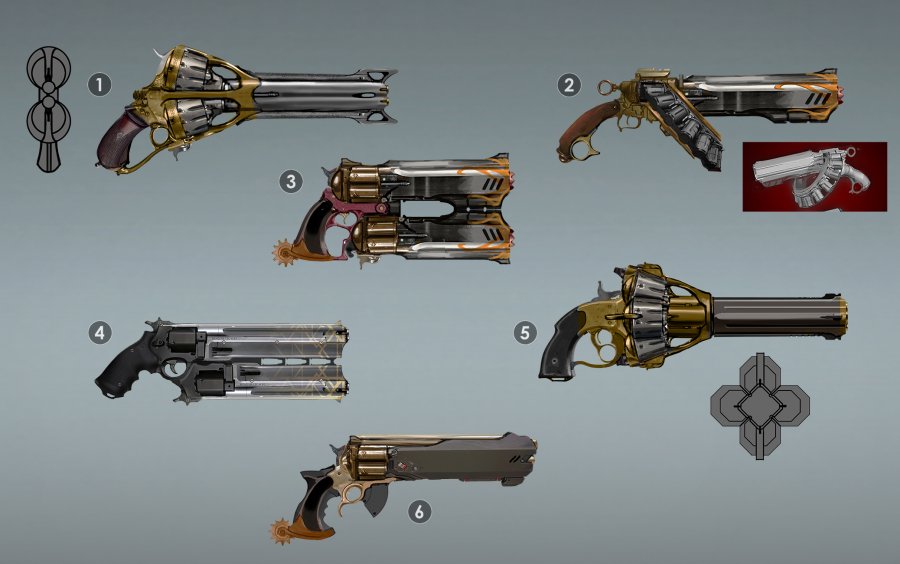
EFFECTS AND ANIMATION
When we decided to bring an Outlaw into Skyforge, the game already had two ranged ability classes - the Archer and Gunner. We had to create something different and we decided to favor realism over fantasy and sci-fi.
Production usually starts with animation and then effects are developed. But when it came to the Outlaw, animation and effects were developed in parallel, for most of his abilities concern shots, hits and the connection between these events. When we started working on attack and ability effects, it became clear that new references were needed to visualize skills. The Outlaw's revolvers are not very big and cannot therefore produce the same powerful effects as say the gunner's plasma beam.
Films, photographs and videos were used as sources of inspiration. We watched recordings of shots in slow motion to study the effect frame by frame. For certain particularly significant abilities concept art is even created. This could be a single picture, an entire storyboard or simply a sketch on a piece of paper. Sometimes this is enough to transmit the idea and start creating the effect.
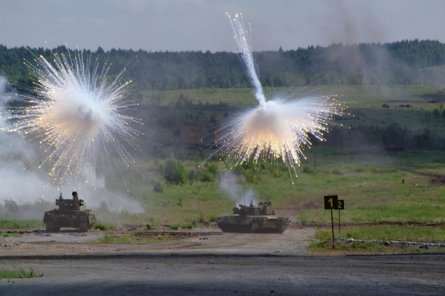
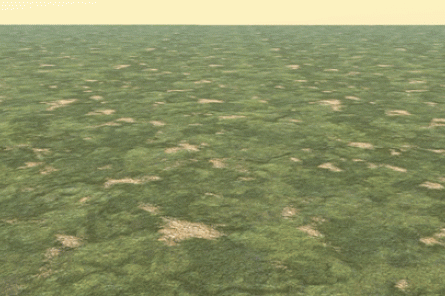
For example, a phosphorus bomb explosion is the prototype for the outlaw's strike.
Creating effects for each class, we aim to highlight a few main colours. For example, Cryomancer effects are blue and white, Berserker effects are red and Witch effects are pink. So any player can recognize what class is using an ability if not the specific ability. Effects cannot always be attributed to some element, which can help determine their color. Ice is white, fire orange, but what color is magic? The more classes there are. the harder it is to make this choice - a rainbow has just 7 colors, but we already have 14 classes! So it is inevitable that colors will cross and we use different graphics and animation to differentiate between the effects.
First of all a simple effect is created, comparable to the outline of a painting and the technical animator connects it to the game together with animations and a game camera. The size or position of the effect may need to be changed, as well as the movement trajectory and so on. Once everything is assembled, we can start in on more details: adding different elements, movement dynamics and color. Taking into account testing and edits, preparing the effects can take from a few hours for regular shots to a week for complex ultimate abilities, which are usually assembled from several related effects. Such an ability for the Outlaw consists of several layers: shots, bullet stream (which is modified depending on distance to target), hits on enemies, firing revolver barrels, flying shells, as well as the lens effect on the camera.
The stronger the ability, the more it additionally influences the weapon. Sometimes to achieve the necessary effect, we use additional functions: impact of the effect on grass and bushes, lighting from light sources, camera shaking and radial screen blurring.
At the same time as preparing effects, animators start creating outlines for future animations. Rough outlines of abilities and features are created on weapon "blanks". Thus we get an almost complete image of the future class, but not in detail (concepts, pre-visualization, animation).
The Outlaw was from the start intended to be a rather fast and agile character, Shooting is performed in any direction. To ensure smooth transition effects, we use the Morpheme program, which allows us to mix such animations. For example, the Outlaw can move back and shoot to the side, but he will always look at the enemy after shooting.
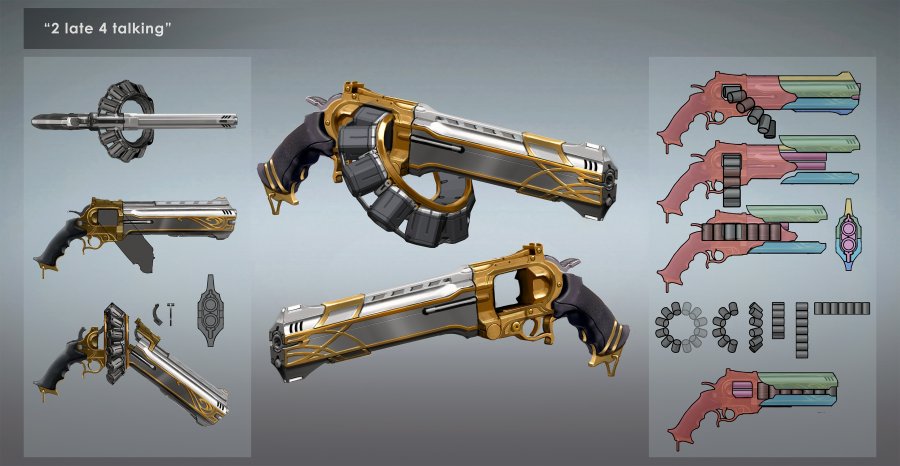
Class weapons in Skyforge consist of various components and can transform while being used. All weapons can become compact outside battle, while still indicating what class you have before you.
The technical animator supports the designers throughout all stages of animation and effect development. He establishes the rules for playing transitions so that the final variant looks natural. He also creates an object in the editor, to which the geometry (model skeleton), animation network (connection) and effects connect, configure and communicate with each other. Such a system consists of several dozen components and a few hundred variables and scripts, which regulate the reaction of the object to differences in the various parameters. For example, if we change the character speed variable, a special script processes this change and sends the relevant parameters to the animation network. As a result, the character starts moving in a way that corresponds to the specified speed (slow steps, jog, run).
At this stage, work also begins on ability and skill sounds.
PROTOTYPE ASSEMBLY
The next stage begins when the class designer finalizes the mechanics. This is a special set of server scripts that describe everything the class can do with the help of its skills. When a rough gameplay prototype is ready, the designers can use it in their work. This enables the team to test out the results with "live" gameplay.
Often at this stage it becomes clear that some abilities do not work as they should or that they can be improved. The designer discusses possible corrections with the team and the necessary changes are made. This process can be repeated several times, if the team has the resources and time to implement what they want within the deadline.
For example, in one of its first iterations the Outlaw's Dancing Grenade ability looked like this: The character through a bomb and shot at it, getting the projectile to go right over the heads of the enemy! Great! Yes, but it does not give the player any special experience. After a dozen uses, the ability stops having the wow factor and starts to get annoying.
Therefore, the ability was changed to make it much more interesting to use. Now you choose what direction to thrown in and the projectile reaches the target in several goes. This means the enemy can move away from the trajectory of the throw, and dodge it in PvP. This makes the ability more interesting. And enabled us to make the damage from mines greater. More explosions — more fun!
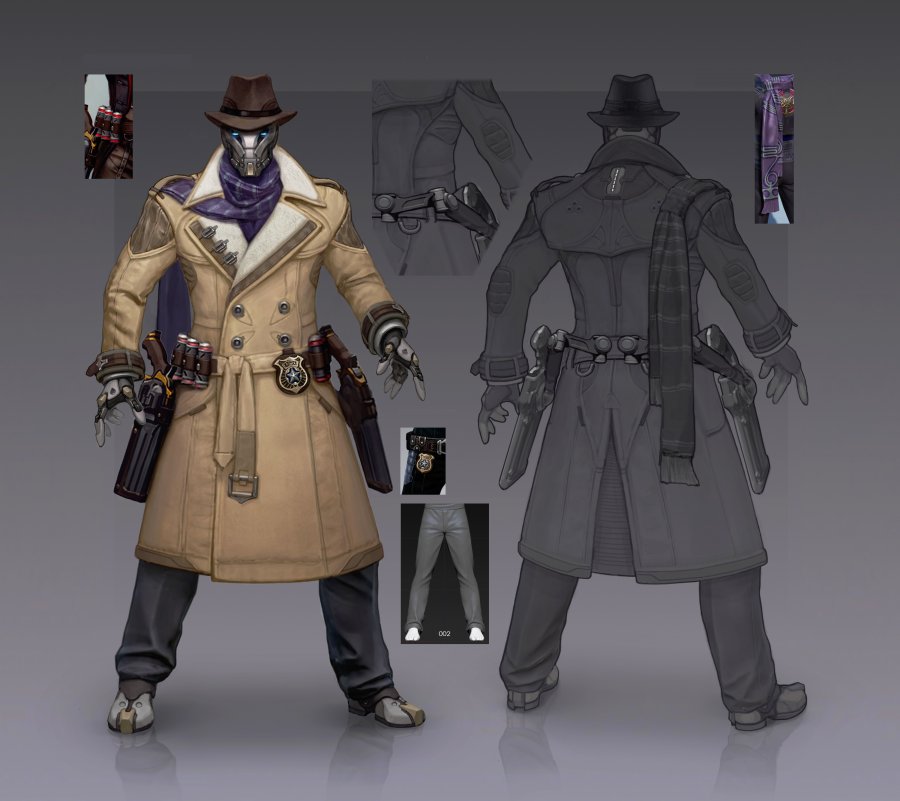
Outlaw Costume.
POLISHING
At this stage the entire team fine tunes the the external appearance of the new class (animation, vfx, sound), adding details and accents.
The concept artist finalizes the weapons and costume (and proceeds to alternative, additional variants), while the animators and effect designers work on more advanced attack and ability versions.
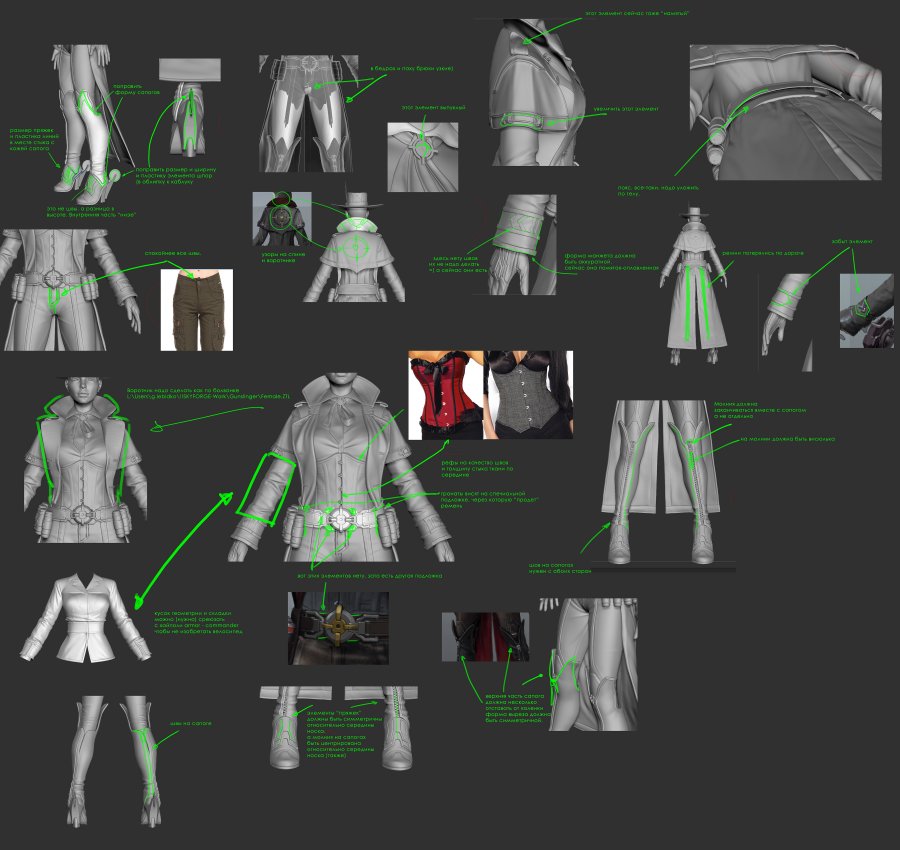
Outlaw costume comments.
After getting a more or less stable version, the entire team tries out the class on the test server and then meets up again to evaluate the results and exchange comments. The mechanics designer and arts director have the last word here. Many animations, mechanics or sounds can be sent back for revision.
When the effects have been confirmed and connected, sounds are recorded along with animations for class abilities and skill icons are created. The same color and elements as the effects, or characteristic for class poses are used but in a simplified form.
![]()
![]()
![]()
![]()
![]()
![]()
The class icon should describe the character as clearly as possible: it could depict a weapon or some easily recognizable characteristic ability element.
The team then meets again and more corrections are made. Usually work on promo illustrations for the future class also begin at this stage.

APPEARANCE IN THE GAME
When the class reaches players, we closely monitor their feedback. For the designers, this is a chance to obtain an objective evaluation of their work and the class designer will gain answers to key questions.
- How convenient is it to play in the new role?
- What problems are players coming across?
- Are they using the class's full potential?
It is difficult to predict all variants of how things will play out. Usually it becomes clear after a few weeks where damage needs to be increased or weakened and the errors that need to be fixed.
That's all for now. If you have any questions, ask them in the comments! We will try and answer the most interesting ones.
 Discord
Discord 

